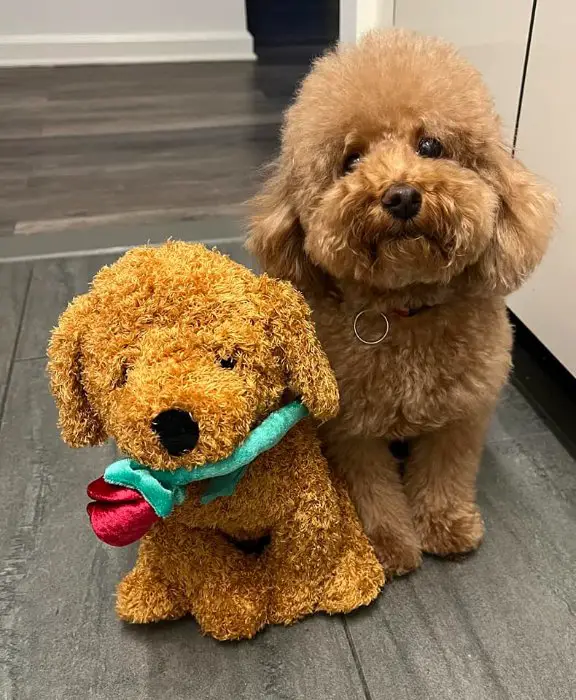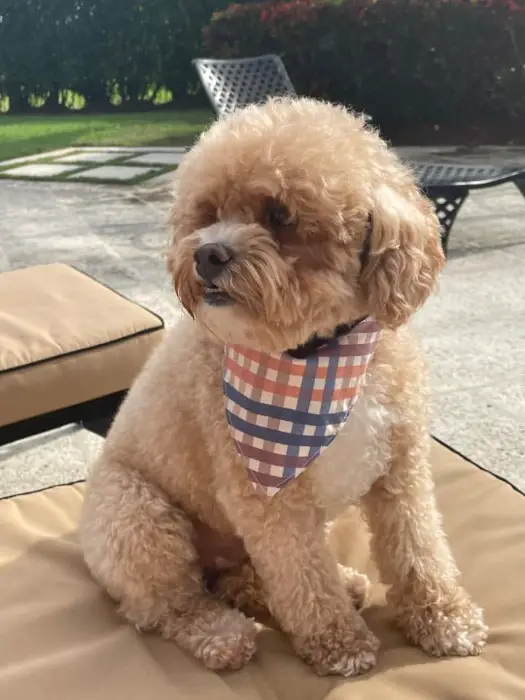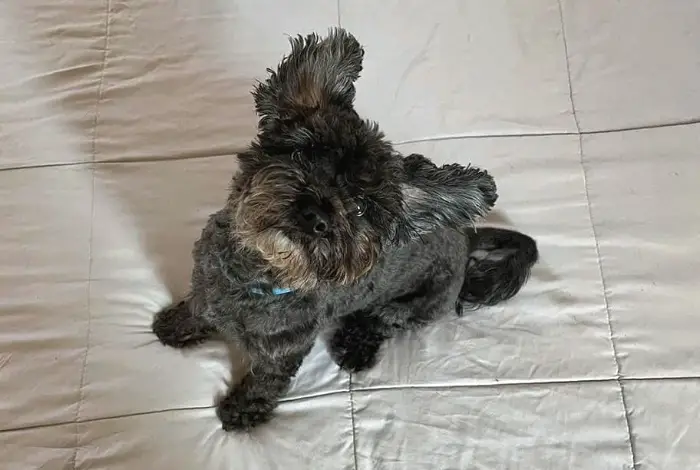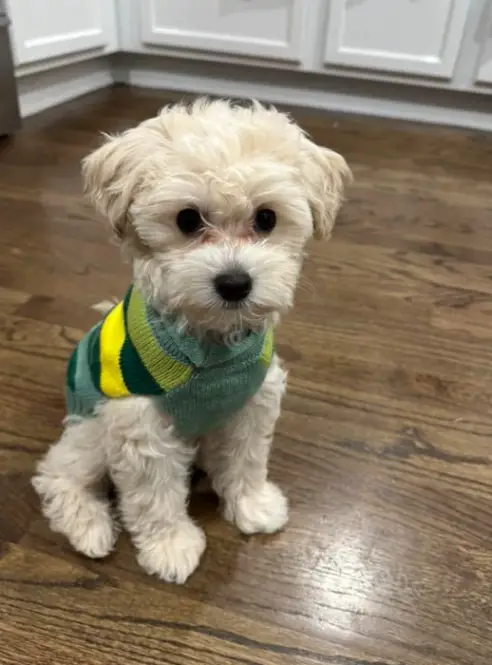If someone in your home is allergic to dogs, it is important to ensure any pet you bring has a hypoallergenic coat. Most Poodle-hybrids are classified as hypoallergenic; or less likely to cause an allergic reaction. But what about the Maltipoo? Are Maltipoos hypoallergenic?

If you suffer from allergies, Maltipoos are one of the most hypoallergenic options. Although no dog is ever perfectly hypoallergenic, the Maltipoo’s poodle genetics mean they shed far less than other breeds.
Now that you know a Maltipoo might be a good option for you, let’s get into the specifics.
Related: Maltipoo Coat Types and How to Care for Them | Maltipoo Price Guide: How Much Does a Maltipoo Cost? | Maltipoo Temperament Guide
What Makes Dogs Hypoallergenic?
Hypoallergenic is a term that means something is less likely to cause an allergic reaction. Just like with hypoallergenic skin products, there isn’t any way to guarantee that everyone will be reaction free. This means that even if a dog is advertised as hypoallergenic, you may still experience an allergic reaction.
But what makes certain dogs less likely to cause an allergic reaction is their coat type.
Most people are actually allergic to dander or the dead skin cells of dogs. And certain coats hold more dander than others. Silky coats do not hold onto the dander, while thick double-coats trap the dander. This affects the number of dead skin cells you encounter when interacting with the dog.
The second thing to take into account is the saliva of the dog. Many people are allergic to the proteins found in animal saliva. Dogs love to lick you in order to express their affection. They also lick their own fur. So a dog that sheds a lot will leave a lot of saliva-coated fur around your home. Some breeds also produce less saliva than others, decreasing the overall amount of saliva in the fur.
Lastly, people may be allergic to pet urine proteins.
Are Maltipoos Hypoallergenic?
Maltipoos are very hypoallergenic. All Maltipoos only have a single coat. Their coats can be very silky and in this case, they don’t shed much at all. This means that they are less likely to induce reactions to pet dander and saliva.
Best Maltipoos For Allergies

Which Maltipoos are the best for those with allergies? Or which are the most hypoallergenic and shed the least? It’s a good idea to familiarize yourself with two aspects of the Poodle-hybrids: coat type and generation.
The more Poodle-like coat and Poodle-backcrossed generations are the best in most hybrids. But because the Maltese are also hypoallergenic, the differences in Maltipoo coats and generations become a case of personal preference.
Avoid excessively curly coats if you cannot commit to extensive grooming. These form mats more easily, which then collect dander and dust.
Related: Maltipoo Generations Explained: F1, F1b, F1bb, F2, F3, Multigenerational
Causes of Excessive Maltipoo Shedding
If you suspect your Maltipoo is shedding more than it should, here are some things you should consider.
Allergies and Skin Irritation
Skin irritation and allergies can cause itching and hair loss. If you think your Maltipoo is scratching or licking a lot, make sure that you examine its skin.
In some cases, you might need to go to the vet to determine the cause of the irritation. But usually, changing your Maltipoo’s food or shampoo will give you an idea of what it is.
In cases where allergies are not the culprit, you may be dealing with something like a fungal infection, but generally, these can be easily identified.
Insufficient Grooming
Not grooming your dog often enough will increase the amount of apparent shedding. This is largely because the excess hair will not be removed. But the lack of grooming can also lead to other problems, such as the skin irritation mentioned above.
Seasonal Changes
Dogs shed when seasons change. This can be especially prevalent when the weather starts to warm. But adjusting your grooming schedule will help prevent this hair from being shed in your home.
Best Practices for a More Hypoallergenic Home

1. Brush Your Maltipoo Regularly
Brushing your Maltipoo is a great way to remove pet dander from their coats. I’ve also found that brushing improves the overall texture of a dog’s coat and removes any mats where dust and dander may be trapped. It also removes loose hair, which may be coated in saliva.
Just make sure your Maltipoo is brushed outdoors where the dander can easily blow away. And, of course, make sure it’s not the person allergic to dogs who brushes your Maltipoo.
2. Bathe Your Maltipoo as Required
Bathing your Maltipoo is great for several reasons. Firstly, it removes any dander, saliva, and urine that may be present in the coat. The water should also remove any loose hair.
Secondly, it keeps your Maltipoo healthy, preventing scratching and licking later on. Just keep in mind that some dogs dislike the feeling of water and will try to scratch or lick while they are still wet.
For the best results, try to discourage this.
If you have very severe allergies or do not see yourself regularly bathing your Maltipoo at home, groomers can be a great way to save yourself the hassle. But remember to take this additional cost into account.
3. Consider Cutting Your Maltipoo’s Hair Short
Most Poodle-hybrids, including the Maltipoo, can be cut quite regularly. Many groomers and breeders even encourage very shortcuts in the warmer months to keep them cool.
This also reduces the overall amount of hair dander and saliva trapped in the hair. But regular grooming has the added benefit of keeping urine out of your Maltipoo’s coat. If you don’t like the look of a typical Maltipoo cut, consider just keeping their bellies and the insides of their hind legs trimmed short.
4. Address Your Maltipoos Health Issues
Health issues can lead to hair loss. But skin issues can lead to irritation, scratching, and licking.
One very common issue is Maltipoo’s allergies. Make sure you use a gentle shampoo like this one that doesn’t irritate your dog’s skin or, in some cases, a medicated shampoo.
5. Don’t Let Maltipoo Fur and Dander Build Up
Although it may seem obvious, many people don’t think of it. Dander and fur build up in your house over time. It doesn’t matter how little your dog sheds if you don’t clean it up.
Make sure you regularly clean – paying special attention to dusty areas – to keep any allergens out of your home and prevent buildup.
6. Remove Carpets or Rugs
Dogs shed dander and hair that can easily cling to carpeted floors or rugs, and despite frequent cleaning, you can’t completely eliminate allergens.
To minimize the risk of allergic reactions, consider removing carpets and instead use wood, tile, or laminate flooring that can be easily cleaned with a vacuum or mop.
And while a rug might be suitable for a pet-free bedroom, it’s better to avoid placing them in shared spaces.
7. Air Purifier
As previously mentioned, dog dander bears a striking resemblance to dust and behaves in a similar manner. Both your skin cells and your furry friend’s will circulate in the atmosphere, increasing the risk of breathing it in for individuals who are sensitive to it.
To minimize the presence of pet dander in the air, using an air purifier like this one is a viable option. This will help to eliminate as much of it as possible from the surroundings.
The Best Way to Know if a Maltipoo is Hypoallergenic Enough

Ultimately, the best way to know if a Maltipoo is hypoallergenic enough for you is to spend some time with it.
If you are trying to adopt an older Maltipoo, playing with it for an hour or two will give you a good idea of whether or not you will react to it.
If you are getting a puppy from a breeder you can speak to them about past litters and how likely your puppy will be to have a hypoallergenic coat. Some breeders actually select parent dogs especially to achieve hypoallergenic puppies.
Related Reading:
